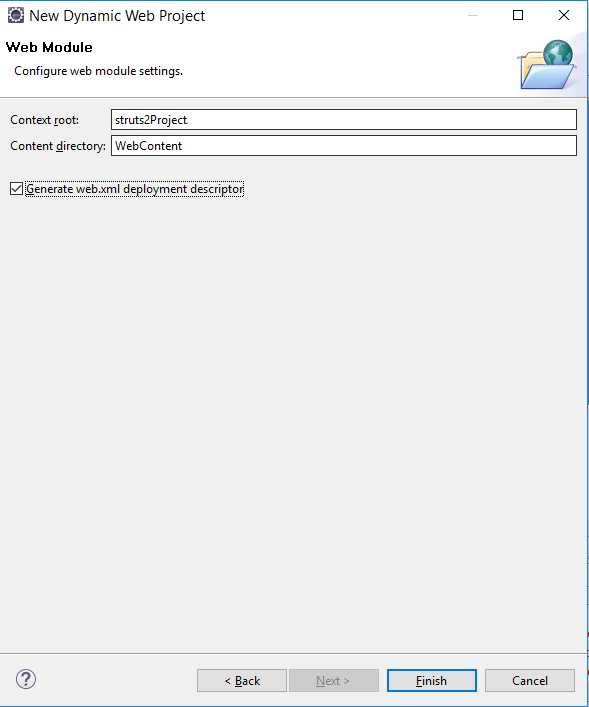标签:
第一步:下载struts2对应的jar包,可以到struts官网下载:http://struts.apache.org/download.cgi#struts252
出于学习的目的,可以把整个完整的压缩文件都下载下来。
里面包括:1 apps:示例应用,对学习很有帮助 ; 2 docs:相关学习文档、API文档等; 3 lib:核心类库,依赖包; 4:src:源代码
第二步:在eclipse新建一个Dynamic Web Project类型工程,一直点next,记得勾选generate web.xml deployment descriptor,才能有web.xml

第三步:导入jar包
struts2有个几个必备的jar包,可以去官网下载struts-min-lib.zip,里面的包就是必须要的jar包。
第四步:编写对应的Action
在src下面新建一个包com.struts.action(注意:命名需要时com.XXX.action的形式),然后再下面新建一个java文件:LoginAction.java
package com.struts.action; import com.opensymphony.xwork2.ActionSupport; public class LoginAction extends ActionSupport { private String username; private String password; public String getUsername() { return username; } public void setUsername(String username) { this.username = username; } public String getPassword() { return password; } public void setPassword(String password) { this.password = password; } public String execute() throws Exception { if("username".equals(this.getUsername()) && "password".equals(this.getPassword())) { return "success"; } else { return "fail"; } } }
第五步:新建结果页面
在WEB-INF新建下面两个文件:
success.jsp
<%@ page language="java" contentType="text/html; charset=ISO-8859-1" pageEncoding="ISO-8859-1"%> <!DOCTYPE html PUBLIC "-//W3C//DTD HTML 4.01 Transitional//EN" "http://www.w3.org/TR/html4/loose.dtd"> <html> <head> <meta http-equiv="Content-Type" content="text/html; charset=ISO-8859-1"> <title>success!</title> </head> <body> success! </body> </html>
fail.jsp
<%@ page language="java" contentType="text/html; charset=ISO-8859-1" pageEncoding="ISO-8859-1"%> <!DOCTYPE html PUBLIC "-//W3C//DTD HTML 4.01 Transitional//EN" "http://www.w3.org/TR/html4/loose.dtd"> <html> <head> <meta http-equiv="Content-Type" content="text/html; charset=ISO-8859-1"> <title>fail!</title> </head> <body> fail! </body> </html>
第六步:在WEB-INF下新建初始页面(根据LoginAction知道需要提交的表单里面有两个参数)
login.html
<!DOCTYPE html> <html> <head> <meta charset="UTF-8"> <title>Insert title here</title> </head> <body> <form action="login" method="post"> 用户名:<input type="text" name="username"> 密码:<input type="password" name="password"> <input type="submit" value="提交"> </form> </body> </html>
第七步:配置在WEB-INF下的web.xml:1、加入struts过滤器 2、配置首页
<?xml version="1.0" encoding="UTF-8"?> <web-app xmlns:xsi="http://www.w3.org/2001/XMLSchema-instance" xmlns="http://xmlns.jcp.org/xml/ns/javaee" xsi:schemaLocation="http://xmlns.jcp.org/xml/ns/javaee http://xmlns.jcp.org/xml/ns/javaee/web-app_3_1.xsd" id="WebApp_ID" version="3.1"> <display-name>struts2Project</display-name> <filter> <filter-name>struts2</filter-name> <filter-class>org.apache.struts2.dispatcher.ng.filter.StrutsPrepareAndExecuteFilter</filter-class> </filter> <filter-mapping> <filter-name>struts2</filter-name> <url-pattern>/*</url-pattern> </filter-mapping> <welcome-file-list> <welcome-file>/WEB-INF/login.html</welcome-file> </welcome-file-list> </web-app>
第八步:配置struts2配置文件,在src目录下新建struts.xml,进行action配置
<?xml version="1.0" encoding="UTF-8" ?> <!DOCTYPE struts PUBLIC "-//Apache Software Foundation//DTD Struts Configuration 2.5//EN" "http://struts.apache.org/dtds/struts-2.5.dtd"> <!-- START SNIPPET: xworkSample --> <struts> <package name="com.struts.action" extends="struts-default"> <action name="login" class="com.struts.action.LoginAction"> <result name="success">/WEB-INF/success.jsp</result> <result name="fail">/WEB-INF/fail.jsp</result> </action> </package> </struts>
结尾:至此完成简单struts2框架的登陆搭建,放进tomcat并启动,就可以通过http://localhost:8080/struts2Project/ 访问。
标签:
原文地址:http://www.cnblogs.com/xmu-chenming/p/5747595.html